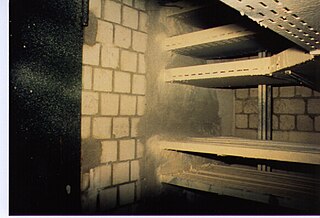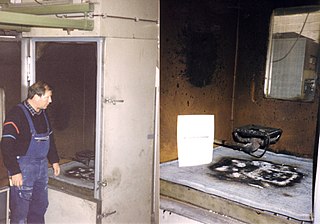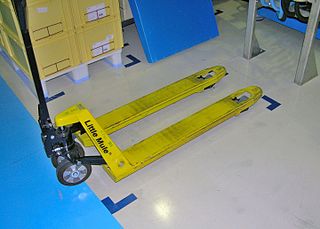
A fire sprinkler system is an active fire protection method, consisting of a water supply system providing adequate pressure and flowrate to a water distribution piping system, to which fire sprinklers are connected. Although initially used only in factories and large commercial buildings, systems for homes and small buildings are now available at a cost-effective price.

An aisle is a linear space for walking with rows of non-walking spaces on both sides. Aisles with seating on both sides can be seen in airplanes, in buildings such as churches, cathedrals, synagogues, meeting halls, parliaments, courtrooms, theatres, and in long passenger vehicles. An aisle floor may be level or, as in theatres, sloping upward from a stage.

A building code is a set of rules that specify the standards for construction objects such as buildings and non-building structures. Buildings must conform to the code to obtain planning permission, usually from a local council. The main purpose of building codes is to protect public health, safety and general welfare as they relate to the construction and occupancy of buildings and structures — for example, the building codes in many countries require engineers to consider the effects of soil liquefaction in the design of new buildings. The building code becomes law of a particular jurisdiction when formally enacted by the appropriate governmental or private authority.
Proposition 65 is a California law passed by direct voter initiative in 1986 by a 63%–37% vote. Its goals are to protect drinking water sources from toxic substances that cause cancer or birth defects and to reduce or eliminate exposures to those chemicals generally, such as in consumer products, by requiring warnings in advance of those exposures, with the intended goal being that companies choose to reformulate their products without the substances rather than simply providing notice of such substances in their product.
The Alquist-Priolo Earthquake Fault Zoning Act was signed into California law on December 22, 1972, to mitigate the hazard of surface faulting to structures for human occupancy.

A beer garden is an outdoor area in which beer and food are served, typically at shared tables shaded by trees.

Fire safety is the set of practices intended to reduce destruction caused by fire. Fire safety measures include those that are intended to prevent the ignition of an uncontrolled fire and those that are used to limit the spread and impact of a fire.

An emergency exit in a building or other structure is a special exit used during emergencies such as fires. The combined use of regular and emergency exits allows for faster evacuation, and emergency exits provide alternative means of evacuation if regular exits are inaccessible.
The publication Life Safety Code, known as NFPA 101, is a consensus standard widely adopted in the United States. It is administered, trademarked, copyrighted, and published by the National Fire Protection Association and, like many NFPA documents, is systematically revised on a three-year cycle.

Dangerous goods (DG), are substances that when transported are a risk to health, safety, property or the environment. Certain dangerous goods that pose risks even when not being transported are known as hazardous materials. An example for dangerous goods is hazardous waste which is waste that has substantial or potential threats to public health or the environment.
The International Code Council (ICC) is a nonprofit standards organization that creates the International Building Code (IBC), a model building code, as well as the International Residential Code (IRC), and other model codes. The IBC has been adopted for use as a base code standard by most jurisdictions in the United States.
A placard is a notice installed in a public place, like a small card, sign, or plaque. It can be attached to or hung from a vehicle or building to indicate information about the vehicle operator or contents of a vehicle or building. It can also refer to paperboard signs or notice carried by picketers or demonstrators.
Building regulations in the United Kingdom are statutory instruments or statutory regulations that seek to ensure that the policies set out in the relevant legislation are carried out. Building regulations approval is required for most building work in the UK.

Passive fire protection (PFP) is components or systems of a building or structure that slows or impedes the spread of the effects of fire or smoke without system activation, and usually without movement. Examples of passive systems include floor-ceilings and roofs, fire doors, windows, and wall assemblies, fire-resistant coatings, and other fire and smoke control assemblies. Passive fire protection systems can include active components such as fire dampers.
Within the context of building construction and building codes, occupancy is the use of a building for the shelter or support of persons, animals or property. A closely related meaning is the number of units in such a building that are rented, leased, or otherwise in use. Lack of occupancy, in this sense, is known as vacancy.

A combustible material is a material that can burn in air under certain conditions. A material is flammable if it ignites easily at ambient temperatures. In other words, a combustible material ignites with some effort and a flammable material catches fire immediately on exposure to flame.

Social customs and laws concerning drinking alcohol in public vary significantly around the world. "Public" in this context refers to outdoor spaces such as roads, walkways or parks, or in a moving vehicle. Drinking in bars, restaurants, stadiums, and other such establishments, for example, is not generally considered to be "in public" even though those establishments are open to the general public.
The International Green Construction Code (IGCC) is a set of guidelines that aim to improve the sustainability and environmental performance of buildings during their design, construction, and operation. It was introduced by the International Code Council (ICC), a non-profit organization that provides building safety and fire prevention codes for the United States and other countries. It is a model code designed to be mandatory where it is implemented.

Floor marking tapes are adhesive tapes used to mark hazards, divide spaces, create aisles, or provide directions. They are commonly used in industrial and manufacturing facilities for floor marking. They are made of multiple different materials, including PVC and vinyl, and vary in thickness from 5-mils to 55-mils for a wide range of durability options for manufacturing facility floor marking. The best floor marking tapes are usually 50 to 60 mils thick. Most tapes come in a variety of color options and even hazard patterns to meet U.S. Occupational Safety and Health Administration/ANSI requirements and other safety standards. Some tapes are made with higher reflectivity and may even glow in the dark.












